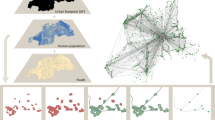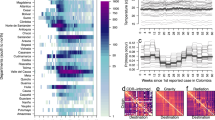Abstract
Mathematical models of viral transmission and control are important tools for assessing the threat posed by deliberate release of the smallpox virus and the best means of containing an outbreak. Models must balance biological realism against limitations of knowledge, and uncertainties need to be accurately communicated to policy-makers. Smallpox poses the particular challenge that key biological, social and spatial factors affecting disease spread in contemporary populations must be elucidated largely from historical studies undertaken before disease eradication in 1979. We review the use of models in smallpox planning within the broader epidemiological context set by recent outbreaks of both novel and re-emerging pathogens.
This is a preview of subscription content, access via your institution
Access options
Subscribe to this journal
Receive 51 print issues and online access
$199.00 per year
only $3.90 per issue
Buy this article
- Purchase on SpringerLink
- Instant access to full article PDF
Prices may be subject to local taxes which are calculated during checkout
Similar content being viewed by others
References
Lane, H. C., Montagne, J. L. & Fauci, A. S. Bioterrorism: a clear and present danger. Nature Med. 7, 1271–1273 (2001)
Dixon, C. W. Smallpox (Churchill, London, 1962)
Fenner, F., Henderson, D. A., Arita, I., Jezek, Z. & Ladnyi, I. D. Smallpox and its Eradication (WHO, Geneva, 1988)
US sounds alarm over smallpox weapon threat. Nature 399, 628 (1999)
Meltzer, M. I., Damon, I., LeDuc, J. W. & Millar, J. D. Modeling potential responses to smallpox as a bioterrorist weapon. Emerg. Inf. Dis. 7, 959–969 (2001)
Kaplan, E. H., Craft, D. L. & Wein, L. M. Emergency response to a smallpox attack: The case for mass vaccination. Proc. Natl Acad. Sci. USA 99, 10935–10940 (2002)
Halloran, M. E., Longini, I. M., Nizam, A. & Yang, Y. Containing bioterrorist smallpox. Science 298, 1428–1432 (2002)
Bozzette, S. A. et al. A model for a smallpox-vaccination policy. N. Engl. J. Med. 348, 416–425 (2003)
Lane, J. M. & Goldstein, J. Evaluation of 21st-century risks of smallpox vaccination and policy options. Ann. Intern. Med. 138, 488–493 (2003)
Kemper, A. R., Davis, M. M. & Freed, G. L. Expected adverse events in a mass smallpox vaccination campaign. Eff. Clin. Pract. 5, 84–90 (2002)
Anderson, R. M. & May, R. M. Directly transmitted infections diseases: control by vaccination. Science 215, 1053–1060 (1982)
Grenfell, B. T., Bjornstad, O. N. & Kappey, J. Travelling waves and spatial hierarchies in measles epidemics. Nature 414, 716–723 (2001)
Anderson, R. M., May, R. M. & McLean, A. R. Possible demographic impact of AIDS in developing countries. Nature 332, 228–234 (1988)
Ferguson, N. M., Donnelly, C. A. & Anderson, R. M. The foot-and-mouth epidemic in Great Britain: pattern of spread and impact of interventions. Science 292, 1155–1160 (2001)
Keeling, M. J. et al. Dynamics of the 2001 UK foot and mouth epidemic: stochastic dispersal in a heterogeneous landscape. Science 294, 813–817 (2001)
Keeling, M. J., Woolhouse, M. E., May, R. M., Davies, G. & Grenfell, B. T. Modelling vaccination strategies against foot-and-mouth disease. Nature 421, 136–142 (2003)
Ferguson, N. M., Donnelly, C. A. & Anderson, R. M. Transmission intensity and impact of control policies on the foot and mouth epidemic in Great Britain. Nature 413, 542–548 (2001)
Anderson, R. M. & May, R. M. Infectious Diseases of Humans: Dynamics and Control (Oxford Univ. Press, Oxford, 1991)
Wallinga, J., Levy-Bruhl, D., Gay, N. J. & Wachmann, C. H. Estimation of measles reproduction ratios and prospects for elimination of measles by vaccination in some Western European countries. Epidemiol. Infect. 127, 281–295 (2001)
Gani, R. & Leach, S. Transmission potential of smallpox in contemporary populations. Nature 414, 748–751 (2001)
Eichner, M. & Dietz, K. Transmission potential of smallpox: Estimates based on detailed data from an outbreak. Am. J. Epidemiol. 158, 110–117 (2003)
Bailey, N. T. J. The Mathematical Approach to Biology and Medicine (Wiley, London, 1967)
Koopman, J. Controlling smallpox. Science 298, 1342–1344 (2003)
Eichner, M. Case isolation and contact tracing can prevent the spread of smallpox. Am. J. Epidemiol. 158, 118–128 (2003)
Lipsitch, M. et al. Transmission dynamics and control of severe acute respiratory syndrome. Science 300, 1966–1970 (2003)
Riley, S. et al. Transmission dynamics of the etiological agent of SARS in Hong Kong: impact of public health interventions. Science 300, 1961–1966 (2003)
O'Neill, P. D. A tutorial introduction to Bayesian inference for stochastic epidemic models using Markov chain Monte Carlo methods. Math. Biosci. 180, 103–114 (2002)
Mollison, D. Simplifying simple epidemic models. Nature 310, 224–225 (1984)
Bailey, N. T. J. & Duppenthaler, J. Sensitivity analysis in the modelling of infectious disease dynamics. Math. Biosci. 10, 113–131 (1980)
Isham, V. & Medley, G. Models for Infectious Human Disease: Their Structure in Relation to Data (Cambridge Univ. Press, Cambridge, 1996)
Acknowledgements
We thank the Royal Society (N.M.F. and M.J.K.), MRC (N.M.F.), Howard Hughes Medical Institute (N.M.F.), BBSRC (M.J.K. and B.T.G.), the Wellcome Trust (B.T.G. and R.M.A.) and the Department of Health (W.J.E., R.G. and S.L.) for funding. The views expressed are not necessarily those of the Department of Health, but we thank staff of the Department for discussions.
Author information
Authors and Affiliations
Corresponding author
Rights and permissions
About this article
Cite this article
Ferguson, N., Keeling, M., John Edmunds, W. et al. Planning for smallpox outbreaks. Nature 425, 681–685 (2003). https://doi.org/10.1038/nature02007
Issue date:
DOI: https://doi.org/10.1038/nature02007
This article is cited by
-
Stochastic dynamics of an SIS epidemic on networks
Journal of Mathematical Biology (2022)
-
A novel geo-hierarchical population mobility model for spatial spreading of resurgent epidemics
Scientific Reports (2021)
-
How resource limitations and household economics may compromise efforts to safeguard children during outbreaks
BMC Public Health (2020)
-
Systematic selection between age and household structure for models aimed at emerging epidemic predictions
Nature Communications (2020)
-
Commentary on Ferguson, et al., “Impact of Non-pharmaceutical Interventions (NPIs) to Reduce COVID-19 Mortality and Healthcare Demand”
Bulletin of Mathematical Biology (2020)



